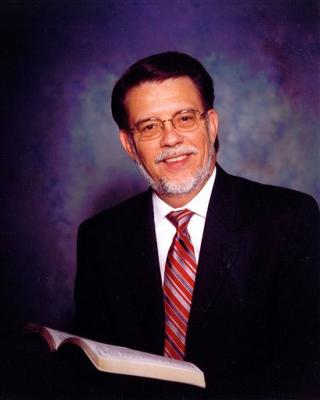 Robert Bachtell is a friend and fellow member of our local church, Twin City Fellowship. He recently did a two-part Sunday School series on young-earth creationism entitled The Case for a Biblical Worldview. Robert believes that the key issue in the debate over origins, whether it’s the creation-evolution debate or the young earth-old earth debate, is how scripture is handled. His case is that if scripture is respected and interpreted carefully, it’s difficult to reach any conclusion but a young-earth view.
Robert Bachtell is a friend and fellow member of our local church, Twin City Fellowship. He recently did a two-part Sunday School series on young-earth creationism entitled The Case for a Biblical Worldview. Robert believes that the key issue in the debate over origins, whether it’s the creation-evolution debate or the young earth-old earth debate, is how scripture is handled. His case is that if scripture is respected and interpreted carefully, it’s difficult to reach any conclusion but a young-earth view.Podcast: Play in new window | Download (Duration: 1:00:07 — 40.9MB)
Subscribe: RSS
An outline of this month’s episode is as follows:
- We started off by describing why a Biblical worldview matters. Robert boils down the debate between Old and Young Earth Creationists to the question of Biblical authority.
- Robert describes the hermeneutical terms “eisegesis” and “exogesis”.
- Much of the discussion revolves around how one interprets the Hebrew word “yom”, which translates to “day” in English. Just like the English, there are three ways to interpret it:
- A 24 hour period of time.
- The portion of that 24 hour period which is between sunrise and sunset. As opposed to the night.
- A historical period of time. “Back in my day…” or “I remember the day when…”
- Robert illustrates the importance of a worldview by telling a story of a magic show in which the magician makes his assistant disappear. As adults, familiar with how magic works, we know it is merely an illusion, slight of hand. However, a child witnesses the same magic trick believing the assistant actually disappeared. The proper worldview (that of the adult) leads to an accurate conclusion of what happened at the magic show.
- In discussing the differences between an atheistic, or secular-humanist worldview and a Christian worldview, the differences are black & white.
- Robert does one-on-one evangelism, and local Universities are his favorite places to go. Universities being popular places among those holding a materialistic worldview, Robert often has to break down the veil between their worldview and his in the process of sharing the Gospel with them. He illustrates to them that the existence of a building is proof of a builder. and likewise the creation, which is far more complex than a building, is proof of a creator.
- He can then invite the person he’s speaking with to step into Robert’s worldview for a moment, to show the implications of that worldview; the nature of sin and the necessity of a savior.
- Robert quotes geneticist professor and self-described Marxist Richard Lewontin:
- “We take the side of science in spite of the patent absurdity of some of its constructs, in spite of its failure to fulfill many of its extravagant promises of health and life, in spite of the tolerance of the scientific community for unsubstantiated just-so stories, because we have a prior commitment, a commitment to materialism. It is not that the methods and institutions of science somehow compel us to accept a material explanation of the phenomenal world, but, on the contrary, that we are forced by our a priori adherence to material causes to create an apparatus of investigation and a set of concepts that produce material explanations, no matter how counter-intuitive, no matter how mystifying to the uninitiated. Moreover, that materialism is an absolute, for we cannot allow a Divine Foot in the door.”

- Materialism relies heavily on science. However, science is merely a tool for developing an understanding of the world around us, and is not a worldview in and of itself.
- Scientific materialism relies on what is observable (seen) in order to understand the world. In contrast, Hebrews 11:3 says that “By faith we understand that the worlds were prepared by the word of God, so that what is seen was not made out of things which are visible.”
- Robert believes that what is clouding the worldview of Old-Earth Creationists is a feeling of intimidation. Materialistic secular-humanists speak with a sense of authority in describing their worldview, which can be intimidating. Old-Earth Creationists attempt to explain their creationist worldview in light of a contradictory explanation that is found in scientific-materialism. Rather than seek out alternative explanations for evidence that seems to contradict their worldview, they surrender to it and revise their own worldview.
- The clearest reading of Genesis 1-2 will lead the reader to understand that the Earth and the Heavens were created in six literal 24-hour days. In addition, Exodus 20:8-11 leaves no room for anything but a literal understanding of the creation week.
- Robert uses the analogy of a sunken shipwreck with many gold coins on it to illustrate how we interpret evidence. If the newest coin found on the shipwreck is dated 1850, we know it couldn’t have sunk before then.
- Evidence of a young earth, and a relatively recent creation:
- The salinity of the oceans. Based on the current salinity, and the rate at which the oceans get saltier every year, an old Earth is all but impossible unless the oceans were filled with freshwater until only recently.
- The Earth’s magnetic field. The magnetic field of the earth is steadily getting weaker. If the earth is older than that suggested by the young-earth view, the magnetic field would have been too strong to support life based on the current rate that it is weakening.

- Much of the explanation of the evidence we see in nature for the age of the universe, or age of the earth, is based on assumptions. Many of these assumptions expose a world-view bias. Examples include radio-metric and radio-carbon dating methods. Radio-carbon dating is built on the assumption that levels of carbon 14 have always been constant, and have always decayed at a uniform rate. If there were ever smaller concentrations of carbon 14 in the atmosphere, or if it ever decayed faster than it does today, dating methods would result in a specimen appearing older than it really is. To complicate the issue, a cataclysmic global flood would result in a decrease in carbon 14 levels.
- The assumption that material processes have always been the same throughout history is called Uniformitarianism.
Scriptures Referenced
- Genesis 1
- Hebrews 11:1,3
- Job 38:4
- Exodus 20:8-11
Additional Resources
- Robert’s original lectures from Twin City Fellowship:
- The Case for a Biblical Worldview Part 1
mp3 Audio | Power Point | Handout PDF - The Case for a Biblical Worldview Part 2
mp3 Audio | Power Point | Handout PDF
- The Case for a Biblical Worldview Part 1
- A young Earth—it’s not the issue! – Ken Ham
- Answers in Genesis: In the Beginning – Echo Zoe Radio episode 17, September 2009
- Steeling The Mind of America 2000 Conference #05 – One Blood: The Biblical Answer To Racism – Ken Ham MP3
I mentioned my first experience with Ken Ham, and this was it, I attended this conference in Keystone, Colorado in August of 2000.
* File courtesy of Firefighters for Christ - Origins – Starlight and Time with Dr. Russell Humphreys (youtube)
Get Connected
Sign up for email notifications of new episodes of Echo Zoe Radio, and follow me on Twitter, and/or Facebook! Note that if you’ve followed Echo Zoe on Twitter in the past, you are probably now actually following my personal Twitter account, and will need to re-follow @EchoZoe for the blog and podcast.




